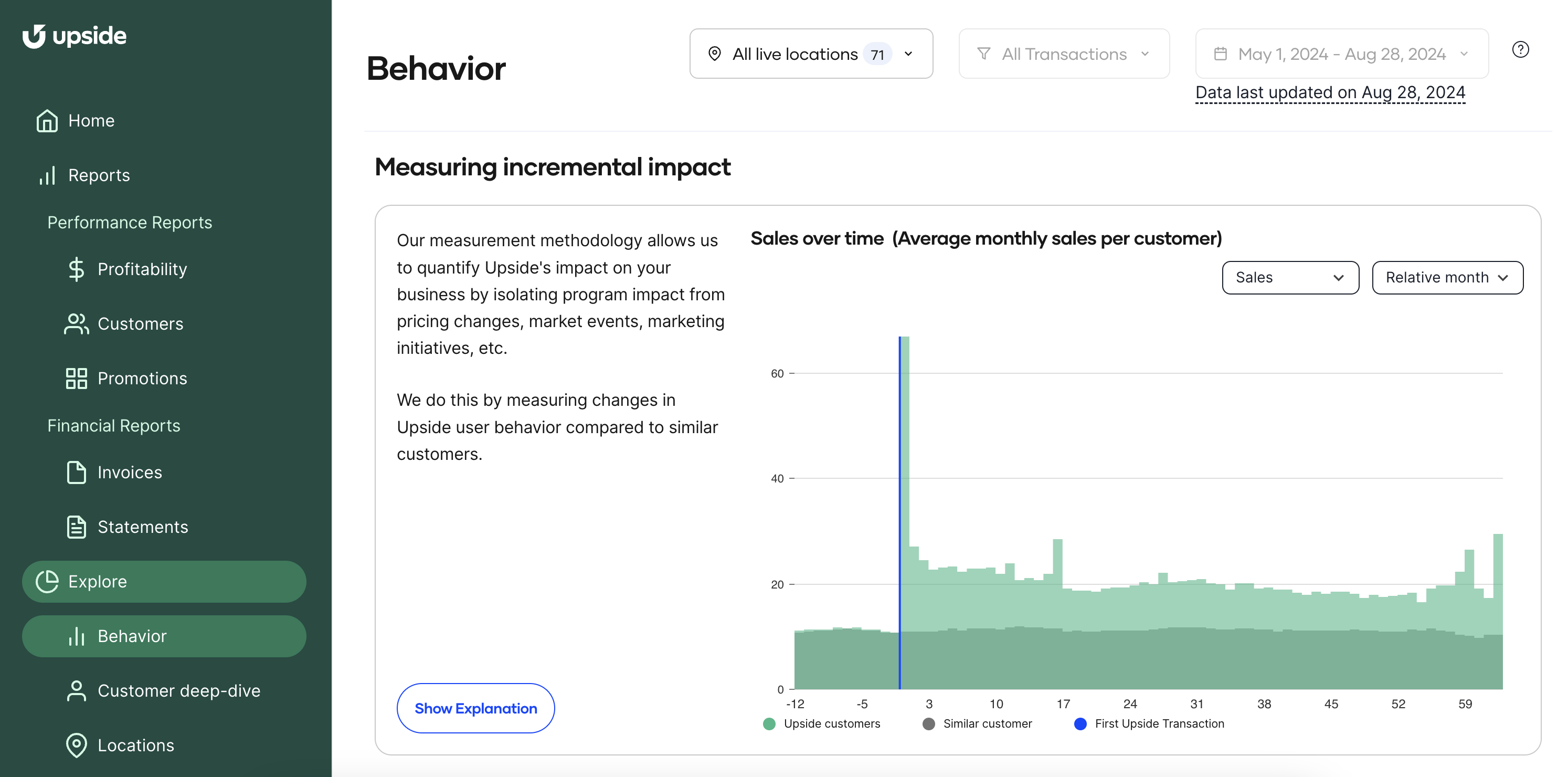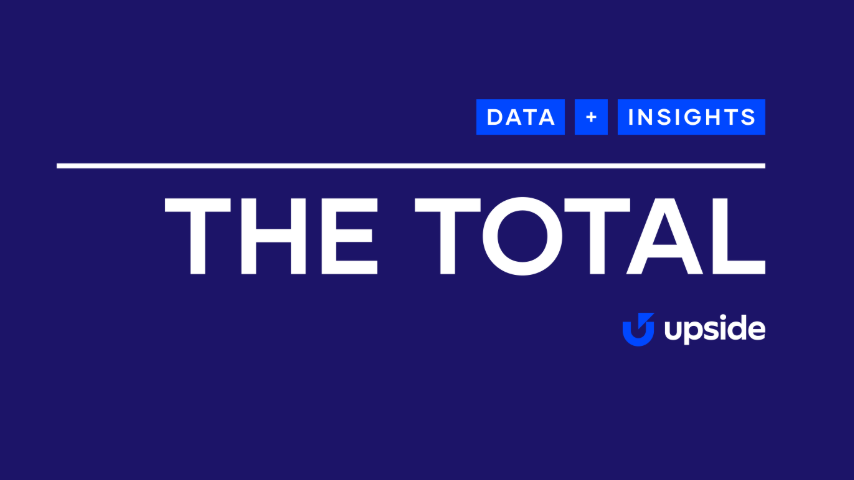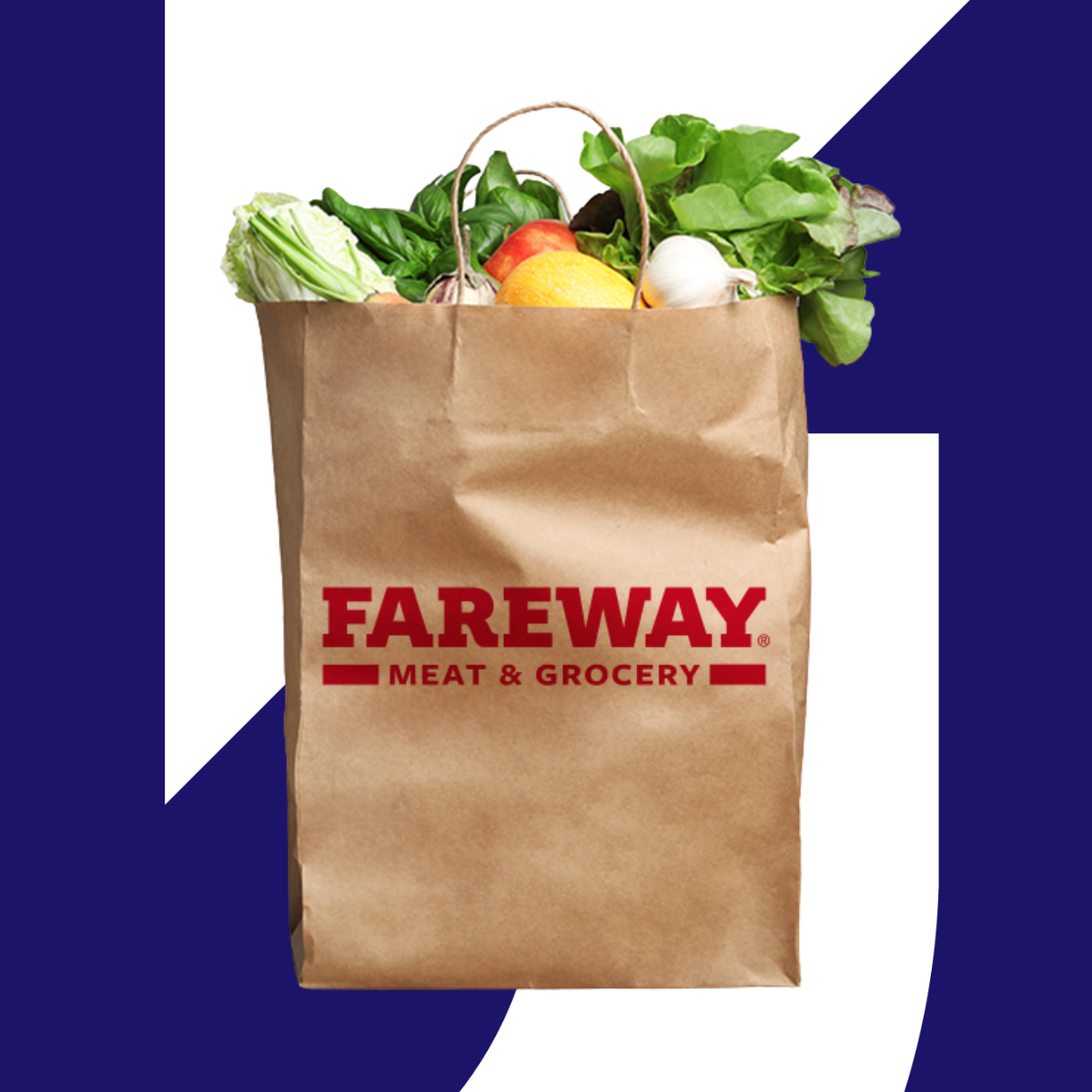Performance-based retail customer acquisition strategies that pay for themselves

The Upside Team
With rising acquisition costs and shifting customer behavior, many retailers are looking for new ways to drive measurable results. Many grocery store rewards programs, restaurant loyalty apps, and convenience store promotions look identical to every competitor down the street. Meanwhile, your customers have become savvy-shoppers who visit five different grocery stores per month, compare prices in real-time, and make shopping decisions hours before leaving the house. Customers have more choices and they're making shopping decisions closer to the moment of purchase.
Most retailers are using the same playbook — points-based rewards, promotions, and ads that look identical to competitors — which makes differentiation harder. When fuel retailers and grocery chains use similar advertising and rewards approaches, it becomes harder to differentiate and gain competitive advantage. You need acquisition strategies that prove their impact through measurable increases in transaction frequency, basket size, and profit that wouldn't have occurred otherwise. The most successful retailers have moved beyond standard marketing strategies to performance-based approaches that only charge when they deliver proven results.
Why your marketing ROI keeps declining
Customer acquisition costs are rising while effectiveness plummets
If you're a grocery retailer, you've likely seen your customer acquisition costs increase year-over-year while same-store sales growth remains flat. Restaurant operators report similar challenges — higher digital advertising costs with lower conversion rates to actual visits. Fuel retailers face the additional complexity of competing on posted prices while trying to drive profitable convenience store transactions.
The measurement problem makes this worse. You can track impressions on your social media campaigns, but you can't prove whether those impressions translated to customers walking through your doors. Your loyalty program shows member transactions, but it can't tell you which members would have visited anyway. This attribution gap makes it challenging to identify which marketing channels deliver genuine returns versus those that appear successful on paper.
Customers are spreading spend across multiple retailers
Grocery shoppers visit multiple stores each month, optimizing their spending across various retailers. Restaurant customers may often use multiple food apps simultaneously, choosing based on convenience and current promotions rather than brand preference. Even fuel customers, traditionally driven by location convenience, now use apps to find the best prices within their driving routes.
This uncommitted behavior spans all customer segments. Your most frequent grocery shoppers might be highly engaged with your store, but they're also participating in two or three competitor loyalty programs. Your regular restaurant customers might love your food, but they're equally willing to try competitors offering better deals. Even fuel customers with location preferences will often drive to competitors for small price differences.
Marketing platforms take credit for sales that were happening anyway
Most marketing platforms claim success by attributing any sale that occurs after a customer interaction, regardless of whether that interaction actually influenced the purchase decision. Your Facebook ads might show impressive return on ad spend (ROAS) while generating zero incremental business. Your email marketing campaigns might claim credit for loyal customers who were already planning to visit.
Without precise measurement, it's hard to separate incremental growth from sales that would have happened anyway. Social media advertising might appear highly effective while primarily taking credit for regular customers' normal shopping behavior. Without proper measurement methodology, you can't distinguish between marketing that drives new business and marketing that simply takes credit for existing business.
Three approaches that drive real results
Performance-based partnerships that only charge for proven outcomes
The most effective customer acquisition strategies operate on performance-based models where you only pay when specific business results are delivered and verified. Unlike traditional advertising that charges for impressions or clicks, performance-based approaches tie all compensation directly to measurable outcomes like incremental transactions and profit.
This eliminates the fundamental misalignment in traditional marketing relationships — when your marketing partners only earn money by generating proven incremental business, their success becomes directly tied to yours. For grocery retailers, this might mean paying only when new customers visit and spend more than historical averages. Restaurant operators might pay only for increased visit frequency beyond baseline behavior.
Marketplace strategies that create network effects for your business
Traditional advertising competes for limited customer attention in crowded channels. Marketplace strategies flip that model by creating collaboration instead of competition — your success benefits from other retailers’ participation, and their success benefits you in return.
When you join a marketplace with complementary retail categories, you benefit from cross-category customer acquisition. Grocery shoppers discovering the marketplace for fuel savings might explore your store's offerings. The network effect becomes more powerful as more retailers participate because it drives higher customer engagement across the entire platform.

Data-driven personalization that changes customer behavior
Your point-of-sale system already collects detailed transaction data from every customer interaction. The most effective acquisition strategies use this existing data to create personalized offers that actually influence customer behavior rather than offering generic discounts to everyone.
Effective personalization goes beyond basic demographics to respond to actual shopping behaviors. Dynamic optimization adjusts offers in real-time based on individual customer behavior, ensuring your promotional spending generates maximum impact while protecting profit margins.
Measurement that cuts through the noise
Test versus control analysis eliminates false attribution
The only reliable method for proving marketing incrementality involves comparing customers who received your marketing intervention with similar customers who didn't. This test versus control methodology isolates the actual impact of your marketing from baseline customer behavior.
Here's how it works for your business: identify customers who participated in your new acquisition program and find other customers with similar historical shopping patterns who didn't participate. Compare spending behavior between these groups over time. The difference represents the true incremental impact of your marketing investment.
For grocery retailers, this might show that loyalty program members who also participated in a personalized promotion program increased their monthly spending by 15% compared to loyalty members who didn't receive promotions. Restaurant operators might discover that targeted offers increased customer visit frequency beyond baseline behavior. Fuel retailers could prove that personalized convenience store promotions improved pump-to-store conversion.

Deconfliction prevents double-counting your marketing results
Proper measurement methodology must account for all your existing marketing activities to ensure new acquisition strategies don't claim credit for results generated by your current programs. This deconfliction process protects the integrity of your performance measurement and ensures accurate return on investment calculations.
Without deconfliction, you might implement a new customer acquisition program that appears highly successful while actually just taking credit for results generated by your existing loyalty program, email campaigns, or seasonal promotions. Proper measurement isolates the impact of each marketing channel to provide clear accountability for actual business results.
Real-time reporting enables continuous optimization
Well-designed acquisition strategies provide detailed reporting that breaks down results by customer segment, location, time period, and promotional type. This granular insight enables continuous optimization based on actual performance data rather than assumptions about customer behavior.
You should be able to see exactly which offers generate the best response rates from different customer segments, which locations benefit most from specific promotional strategies, and which times of day or week produce optimal results. This level of detail enables precise optimization that maximizes both customer acquisition and profit margins.
Industry-specific strategies that work for your business type
Grocery: turning cross-shoppers into primary customers
The average grocery store has unused capacity, meaning there's an opportunity to drive incremental transactions without increasing operational costs. The key lies in capturing a larger share of your customers' total grocery spending rather than trying to achieve exclusive loyalty.
Focus on complementing your existing grocery store rewards program with personalized offers that target specific shopping behaviors. Channel blurring has intensified competition as convenience stores expand fresh food offerings, so your acquisition strategy should target customers who might be satisfying grocery needs through convenience or restaurant purchases.
Fuel and convenience: converting pump customers into store customers
Many fuel customers focus solely on fuel purchases, representing potential opportunities for convenience store engagement. Effective customer acquisition focuses on improving pump-to-store conversion while attracting new customers to both fuel and convenience offerings.
Geographic exclusivity provides powerful competitive advantages because location convenience drives customer choice. Advanced acquisition strategies enable targeted incentives for specific customers without requiring sign price changes that affect your pricing strategy or traffic patterns.
Restaurants: filling empty seats with profitable customers
Most restaurants operate below capacity during significant portions of their operating hours. Customer acquisition should focus on filling these capacity gaps with incremental customers who wouldn't have visited otherwise, rather than just shifting existing customers from busy periods to slow periods.
Distinguish between new customer acquisition and frequency building among existing customers — new acquisition requires trial-focused offers while frequency building targets existing customers for more visits or larger transactions. Integration with your existing point-of-sale systems ensures strategies operate within your workflows while providing performance reporting.
The metrics that actually matter for your business
Go beyond traditional vanity metrics and focus on what truly drives profit
Traditional marketing metrics can mislead retail businesses because they don't distinguish between incremental business and sales that would have occurred anyway. Return on ad spend (ROAS) is particularly problematic because it counts both new sales and sales from customers who would have bought anyway. Focus on incremental revenue versus total attributed revenue — incremental revenue measures only additional sales generated specifically by marketing efforts that wouldn't have occurred otherwise. Customer lifetime value (CLV) impact determines whether your acquisition strategies build long-term relationships or just generate one-time transactions, creating compounding returns on your marketing investment.
Track performance indicators that predict business growth
Monitor repeat visit frequency among customers acquired through different channels. Effective programs should generate customers who visit more often than your baseline customers. For grocery retailers, this might mean acquired customers visit twice monthly instead of once monthly.
Track average transaction size improvements to see if you're influencing purchasing behavior positively. The best programs drive both increased visit frequency and larger purchases per visit.
Measure customer retention rates among acquired customers compared to your baseline retention. Effective programs attract customers who find genuine value in your offerings rather than just promotional hunters.
Building your acquisition strategy
Layer complementary approaches for maximum impact
The best retail acquisition strategies combine multiple approaches that reinforce each other's impact rather than competing for attribution credit. Your loyalty program, personalized promotions, and partnership strategies should work together to create compound benefits. Coordinate timing and messaging across different channels to avoid customer confusion — sequence your marketing touchpoints to guide customers through awareness, trial, and retention stages systematically. Ensure your measurement framework accurately attributes results to appropriate channels while recognizing collaborative effects between different approaches that influence customer purchase decisions.
Integrate with your current operations
Any acquisition strategy should enhance your existing operations without requiring significant changes to staff workflows, point-of-sale systems, or customer service procedures. The best solutions integrate with whatever loyalty programs, POS systems, and operational processes you currently use while minimizing staff training requirements. Choose acquisition approaches that operate transparently within your existing workflows and plan for technical integration that works with your current infrastructure while providing room for future expansion.
Your competitive advantage starts with performance-based results
The retail industry is shifting from traditional marketing toward performance-based acquisition strategies that prove their business impact. Early adoption provides first-mover advantages while competitors continue spending on traditional advertising that can't prove incrementality. You can invest in strategies that only charge when they deliver measurable business results, enabling better use of your marketing budget while reducing risk.
When evaluating potential acquisition partners, prioritize solutions that demonstrate rigorous measurement methodologies and offer performance-based compensation structures. Look for marketplace-based solutions that combine personalized promotion capabilities with performance-based pricing. These approaches provide the accountability, competitive differentiation, and measurable results your business requires for sustainable growth in the retail environment.
See how Upside works for retailers like you
Upside is the digital marketplace that connects your business with nearby consumers through personalized cash back offers that actually change shopping behavior. 100,000 retailers nationwide are on our platform — from independent operators to major chains — across grocery, fuel and convenience, restaurant, and hardware categories.
Unlike traditional marketing platforms that charge for impressions or clicks, we operate on a performance-based model where you only pay when we deliver proven incremental profit to your business. Our proprietary measurement methodology uses test versus control analysis to ensure every transaction we claim credit for represents real business growth you wouldn't have achieved otherwise.
We complement your existing loyalty programs and marketing efforts rather than competing with them. Our platform integrates with your current POS systems without requiring operational changes or staff training. Most importantly, we provide exclusivity zones that prevent nearby competitors from participating in our program, giving you a clear competitive advantage.
Ready to see how Upside can work for your business? Request a demo to learn how we can help you capture more customer transactions and drive measurable profit growth without any upfront investment or operational changes.
Frequently asked questions
Will new customer acquisition strategies conflict with my existing marketing?
The best strategies complement your current efforts rather than competing with them. Proper measurement includes deconfliction to ensure new strategies don't take credit for results from your existing loyalty programs or campaigns. Look for partners who can prove incremental impact through test versus control analysis that accounts for all your other marketing activities.
How do marketplace strategies work differently than traditional advertising?
Traditional advertising competes for limited attention where more competitors mean higher costs. Marketplace strategies create network effects — when more retailers participate, the platform becomes more valuable for customers, benefiting all retailers. Only a certain amount of fuel and food locations can be on the platform in a certain area, which funnels more people to our partner sites. If you're a grocery retailer on a marketplace with fuel and restaurants, you benefit from customers who discover the platform for fuel savings but explore your grocery offers.
What questions should I ask potential customer acquisition partners?
Ask how they measure incremental impact and whether they use test versus control analysis. Find out if they offer performance-based pricing where you only pay for proven results. Understand how their solution integrates with your existing systems — the best require no operational changes. Most importantly, ask how they ensure results don't conflict with your other marketing efforts.
Share this article:
The Upside team is made up of data scientists and industry experts who are passionate about delivering empowering content to our readers. With a focus on providing practical insights and meaningful perspectives, we create engaging materials across a wide range of topics. From exploring industry trends and offering expert analysis to sharing useful tips and inspiring ideas, our team works diligently to provide you with the information you need to thrive.
Request a demo
Request a demo of our platform with no obligation. Our team of industry experts will reach out to learn more about your unique business needs.









.png)





